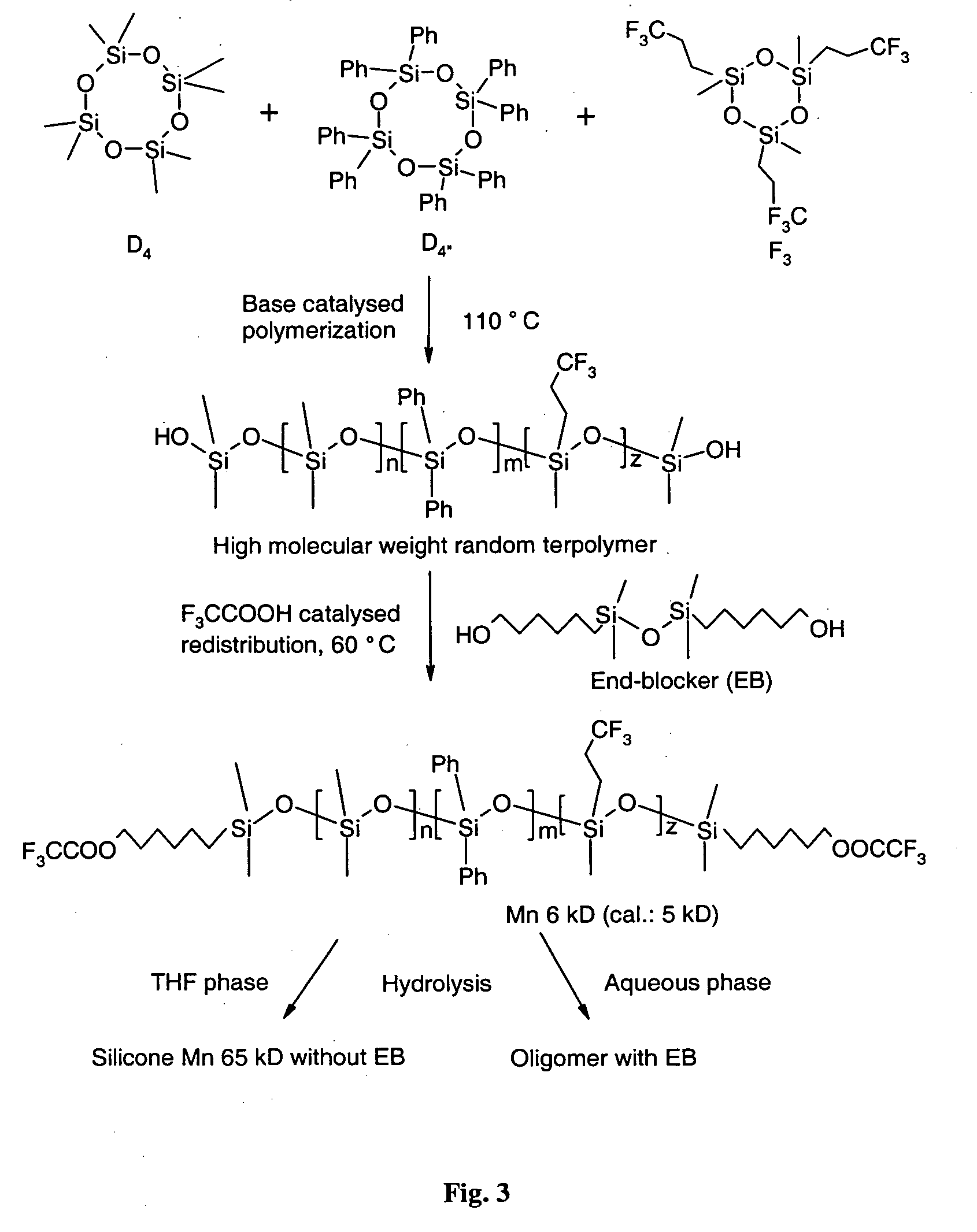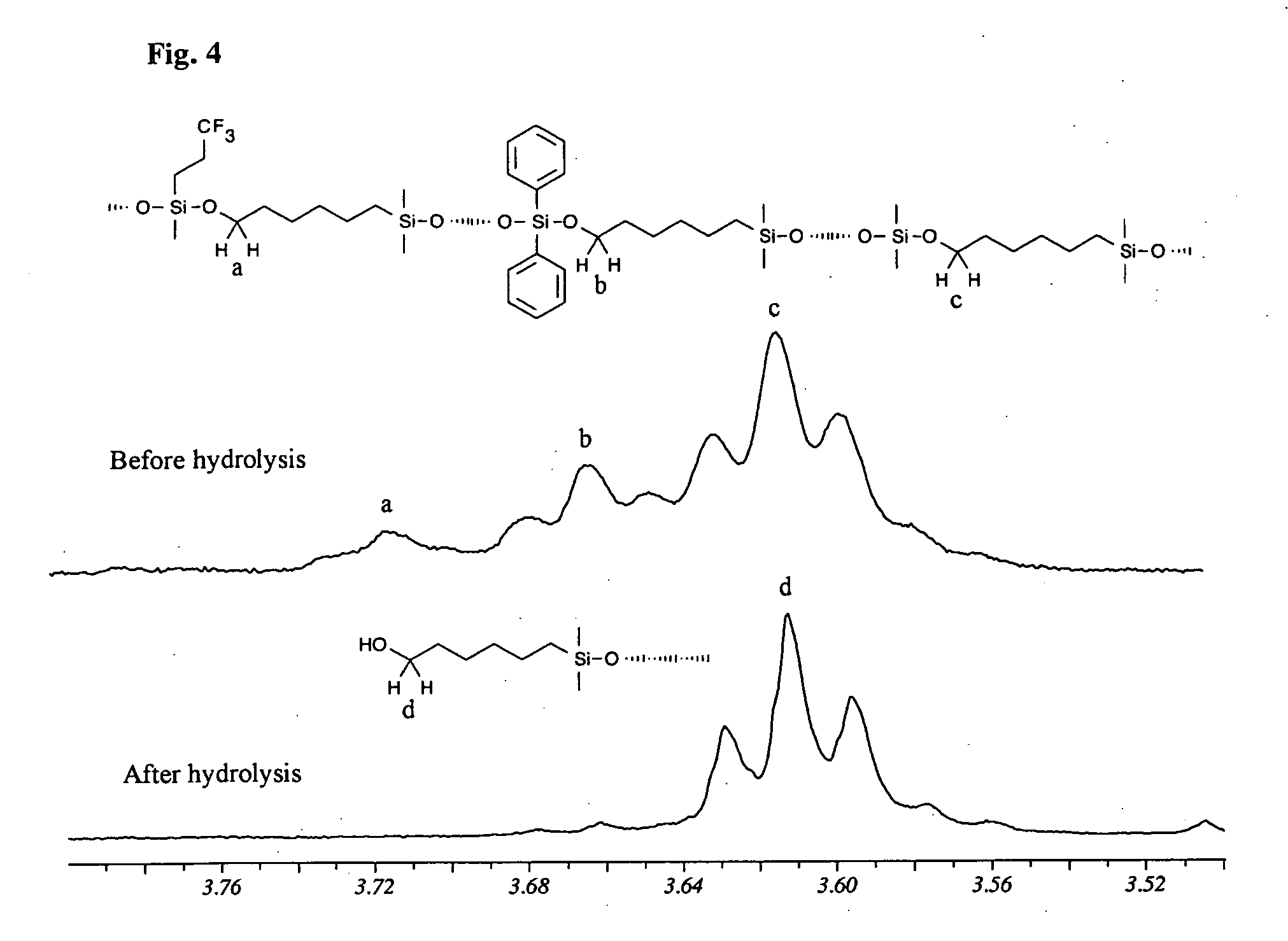Polysiloxanes, method of synthesis and ophthalmic compositions
a technology of polysiloxanes and ophthalmic compositions, applied in the field of polysiloxanes, can solve the problems of vitreous fluid cloudiness, scarring or abrasion, edema, etc., and achieve the effect of stable, easily and rapidly photo-crosslinked
- Summary
- Abstract
- Description
- Claims
- Application Information
AI Technical Summary
Benefits of technology
Problems solved by technology
Method used
Image
Examples
example 1
Synthesis of trifluoroacetyl-hexyl Terminated poly(dimethyl-co-diphenyl-co-methyltrifluoropropyl-siloxane) (I).
[0047] A Schlenk balloon (100 ml) equipped with a mechanical stirrer is charged with D4 (8.45 g, 28.5 mmol), F3 (2.12 g, 4.52 mmol), and D″4 (1.62 g, 2.04 mmol) in THF (2 ml) and tetramethylammonium hydroxide pentahydrate (90 mg) is used as catalyst. The reactor is flushed with nitrogen and heated to 110° C. to initiate polymerization. The molecular-weight and consequently the viscosity becomes high after two days of reaction, which causes stirring problems. At this point, the temperature is raised to 160° C. in 20 min in order to decompose the catalyst. The reaction mixture is cooled to 60° C., and 1,3-bis(6-hydroxy-hexyl)-1,1,3,3-tetramethyldisiloxane (0.81 g, 2.43 mmol) as end-blocker and trifluoroacetic acid (1.14 g, 10 mmol, 0.8 ml) are added in 2 ml TIF. After 24 h of stirring at 60° C., the mixture is dissolved in 50 ml diethyl ether, washed with water (2×100 ml) an...
example 2
Synthesis of Hydroxyhexyl-Terminated poly(dimethyl-co-diphenyl-co-methytrifluoropropyl-siloxane) (II) via hydrolysis of I
[0048] Trifluoroacetyl-hexyl terminated terpolymer (5 g) is dissolved in 30 ml THF and an aqueous solution of sodium carbonate (2.5%, 30 ml) is added. The biphasic mixture is heated to 60° C. and vigorously stirred for 48 h followed by separation of the two phases. The organic phase is dried with sodium sulphate and magnesium sulphate in turn. The solvent is removed under vacuum, resulting in viscous oil (9.6 g, 96%). 1H-NMR (400 MHz, CD2Cl2, ppm): δ 7.65 (3.9 H, bs, o-phenyl), 7.38 (5.7 H, m, m-, p-phenyl), 2.2-1.9 (4.4 H, m, —Si—CH2—CH2—CF3), 0.84-0.63 (3.6 H, m, —Si—CH2—CH2—CF3), 0.21-0.06 (100 H, m, —Si—CH3), nd20 1.4263. The aqueous phase is extracted with diethyl ether (3×20 ml) and the combined ethereal layers are dried with sodium sulphate and magnesium sulphate. After the solvent is stripped off under vacuum, a trace of colorless oil is recovered (0.3 g,...
example 3
Synthesis of II via 1,3-bis(6-hydroxyhexyl)-1,1,3,3-tetramethyldisiloxane as End-Blocker.
[0050] A Schlenk balloon (100 ml) equipped with an overhead stirrer is charged with D4 (8.45 g, 28.5 mmol), F3 (2.12 g, 4.53 mmol), D″4 (1.62 g, 2.04 mmol) and 1,3-bis(6-hydroxyhexyl)-1,1,3,3-tetramethyldisiloxane (0.41 g, 1.23 mmol) (which is used as end-blocker) in 2 ml THF and tetramethylammonium hydroxide pentahydrate (90 mg) (which is used as catalyst). The reactor is heated to 110° C. and flushed with nitrogen. The mixture is cooled after 12 h of reaction to room temperature since longer reaction time causes gelation. Hydrochloric acid (0.2 ml 35%) in 10 ml THF is added to liberate the hydroxyl end-group via hydrolysis or protonation. The hydrolysis is monitored by means of an ATR-IR spectrometer. At the end of the hydrolysis (60 min) the silicone oil is taken up with 50 ml diethyl ether and extracted with water (2×100 ml) and is then washed with brine (30 ml). The ethereal layer is dried...
PUM
| Property | Measurement | Unit |
|---|---|---|
| Density | aaaaa | aaaaa |
| Structure | aaaaa | aaaaa |
| Refractive index | aaaaa | aaaaa |
Abstract
Description
Claims
Application Information
 Login to View More
Login to View More - R&D
- Intellectual Property
- Life Sciences
- Materials
- Tech Scout
- Unparalleled Data Quality
- Higher Quality Content
- 60% Fewer Hallucinations
Browse by: Latest US Patents, China's latest patents, Technical Efficacy Thesaurus, Application Domain, Technology Topic, Popular Technical Reports.
© 2025 PatSnap. All rights reserved.Legal|Privacy policy|Modern Slavery Act Transparency Statement|Sitemap|About US| Contact US: help@patsnap.com



